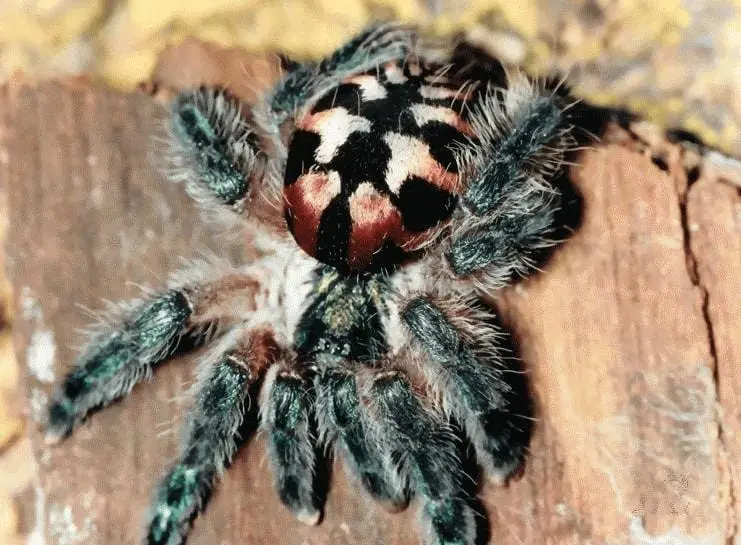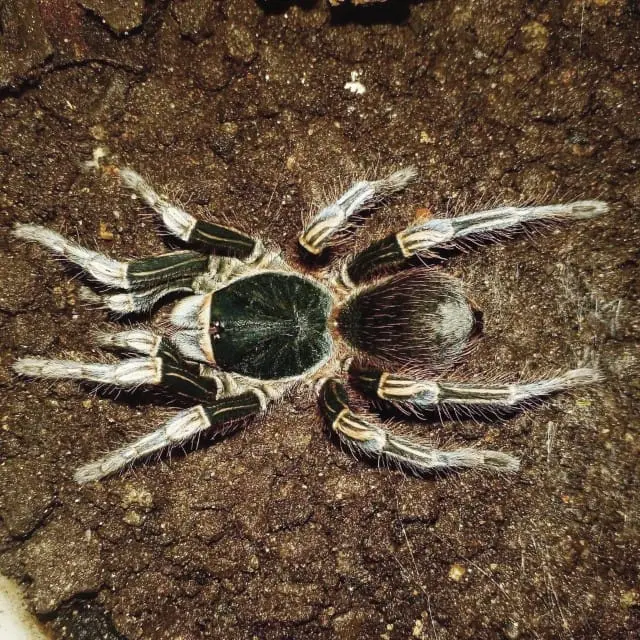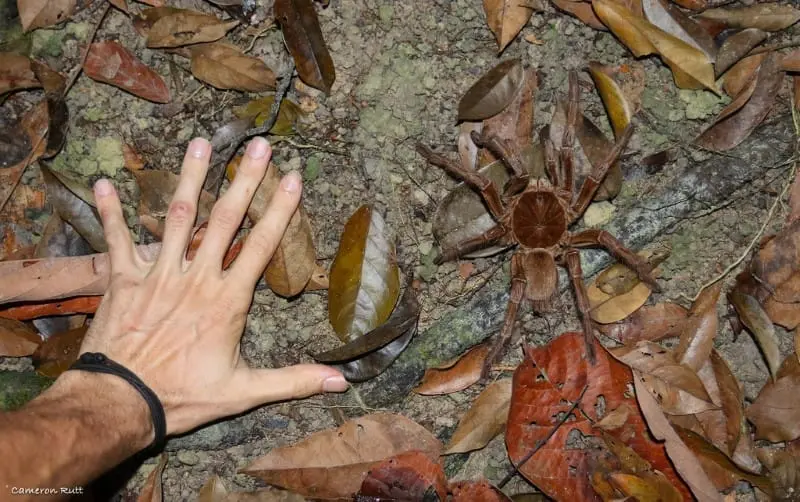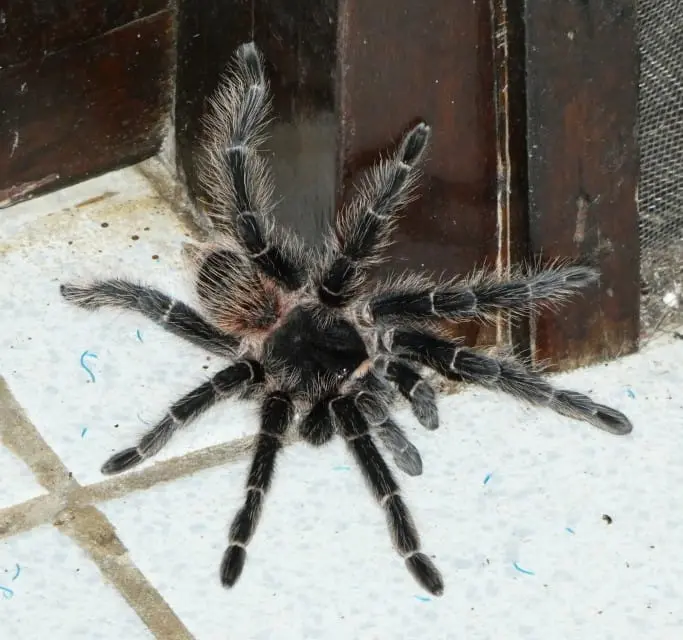Tarantulas in Brazil
Tarantulas appeared in the Americas about 120 million years ago — during the Cretaceous period1. Since then, they have diversified and spread across all continents, with more than a thousand species identified today.
Although they are often confused with wolf spiders or Brazilian wandering spiders, we can identify tarantulas because they are generally hairier, more robust and larger, with body size ranging from 2 to 11 cm (0.5 to 4 in), and the distance between the tip of one leg and the tip of the other from 8 to 30 cm (3 to 12 in). In addition, their pedipalps are so long that they resemble another pair of small legs.
Although many tarantulas are big and scary, some species are small and are among the most beautiful spiders in the world. This is the case with the Brazilian jewel tarantula (Typhochlaena seladonia), its body (without legs) is only about 2 cm long. It is a very rare species, found only in a fragment of the Atlantic Forest in Bahia and Sergipe.2

Tarantulas live in small burrows up to 1 meter (3 feet) deep in the ground or in trees — without ever going to the ground. While arboreal species usually live in a silken “tent,” terrestrial species line their burrows underground to stabilize them and make climbing up and down easier.
Unlike many spiders, tarantulas do not weave webs to hunt; their primary method of capture is ambush. Still, these spiders can’t see much more than light, darkness, movement, and touch is their most acute sense.
So by lining their burrow and its surroundings with silk, the crabs use their bristles as sensory organs, able to pick up vibrations, chemical signatures, and wind direction — helping them to detect the movements of passing prey.
Armed with their huge, powerful chelicerae, crabs are adapted to hunt large arthropods such as centipedes, millipedes, and other spiders. Larger ones can even feed on small vertebrates such as lizards, mice, bats, birds, and some snakes.
So tarantulas hunt actively and don’t wait for their prey to fall or get caught in their webs like many other spiders do.
Stinging bristles and bite
Tarantulas have several ways of defending themselves, one of which is to throw the urticating bristles on their abdomen into the air. Some species have more stinging bristles than others, and these can cause anything from simple skin irritation to penetration of the cornea or inhalation, resulting in permanent damage to the eyes and respiratory system if exposed. Although such complications are rare,3 it is recommended that protection be worn when handling these animals.

Tarantulas also use these bristles to mark territory or line their shelters preventing other insects from feeding on their young. Once pulled out, the stinging bristles do not grow back, but are replaced with each ecdysis.
Another defense method used by some tarantulas is to create a stridulation by rubbing their legs against their abdomens — the sound produced serves as a warning to ward off animals or people that might injure them.
In addition, it is common for them to raise their front paws and show their large fangs as an attempt to intimidate their opponent, then they may slap them with their front paws. If they still feel threatened, their next reaction would be to run away. However, if no escape route is available and as a last resort, tarantulas may bite.
All tarantulas are poisonous, but their venom is not dangerous to humans. In addition, they are known to often give “dry bites”, that is, they bite and do not inject venom into the wound. The bite of many species is like a wasp bite, and can cause from simple discomfort to spasms for several days. The bird-eating Goliath spider (T. blondi), for example, has fangs up to 3 cm (1 inch) long that can cause very painful bites. Also, its bristles are exceptionally dangerous.
World’s Largest Spiders

Being generally large spiders, it is within this family that the world’s largest spiders are found.The pink-footed Goliath spider (Theraphosa apophysis) is considered the spider with the longest legs, while the bird-eating Goliath spider (T. blondi), is the heaviest. Both are found in only a few regions of the Amazon rainforest.
Two other species that rival the size of the Goliath spiders are the Brazilian salmon pink bird-eating (Lasiodora parahybana) and the Bahia scarlet (L. klugi) — endemic species found only in the Northeast.
What to do if you find a crab?
Tarantulas are found all over Brazil; in urban areas they are more likely to be seen near green areas such as parks. They are nocturnal, but can be seen walking during the day, especially in the summer when rainy and cloudy days make the sky darker.
In drier regions of the country, they usually reproduce when food and moisture are more abundant, so although they are usually docile spiders, they may show some aggression during this period to protect their eggs4 Still, biting is usually the last defense of these animals, and although painful, their venom is not dangerous to humans.

People who are unfamiliar with these animals should be careful not to touch them - avoid contact with the bristles. If you encounter a tarantula in your home, keep your distance and carefully remove it with a long object. There is no need to kill it, as they are important for controlling certain animals such as mosquitoes, cockroaches, or spiders with dangerous bites.
Conservation and Breeding
Although many people consider tarantulas to be repulsive and dangerous creatures, there is a growing segment of the world’s population that appreciates them and keeps them as pets. However, tarantulas are not pets and it is illegal to breed them in Brazil! Their capture and sale is considered an environmental crime and can lead to imprisonment. Nevertheless, a large amount is sold illegally, including abroad through animal trafficking5.
Certain species, such as the highly sought after Brazilian Jewel Tarantula, are endemic and rare. Their removal from the wild for commercial purposes could extinguish the species at any time. In addition, there is a risk that these animals will escape or be abandoned by their owners in regions outside their habitat, threatening to unbalance the local fauna.
Below is a video by biologist Richard Rasmussen where he gives some more details and shows all the care we should take with these spiders:
Read more at:
-
Live Science - Tarantulas conquered Earth by spreading over a supercontinent, then riding its broken pieces across the ocean ↩︎
-
About trapdoors and bridges – New insights in the little-known ecology and lifestyle of the genus Typhochlaena C.L. Koch, 1850", British Tarantula Society Journal, 32 (3): 3–29 ↩︎
-
Neto, EMC Aves-aranhas (Arachnida, Mygalomorphae) percebidas pelos habitantes da aldeia de Pedra Branca, Bahia, Brasil. J Etnobiologia Etnomedicina 2 , 50 (2006). https://doi.org/10.1186/1746-4269-2-50 ↩︎
-
BMJ - Eye disease associated with handling pet tarantulas: three case reports ↩︎
-
Repositório INPA - First record of Theraphosa apophysis (Tinter, 1991) (Araneae, Mygalomorphae, Theraphosidae) in Brazil ↩︎
